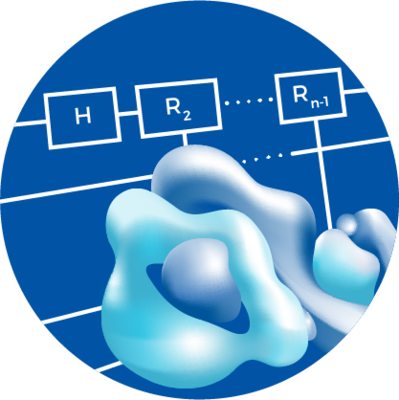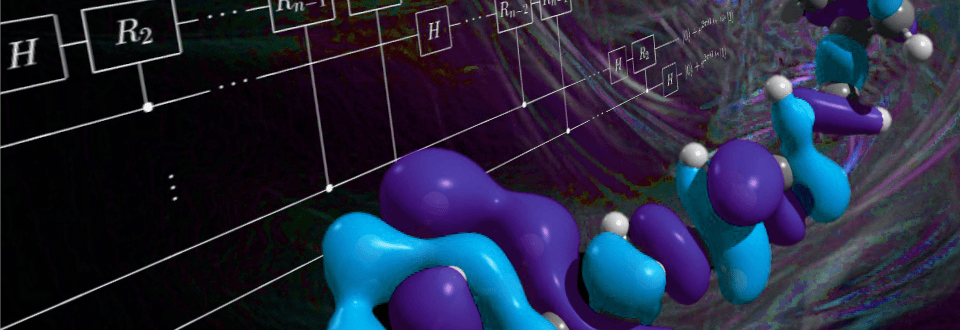

Our work in the quantum information subfield follows the integrated approach to quantum science embodied in the NarangLab. At the hardware level we work on many of the most promising quantum computing technologies – from the well established super-conducting platforms to photonic architectures with their promise of faster, potentially room-temperature devices – in collaboration with partners across industry and academia. Higher up the quantum technology stack, we work on quantum firmware-level circuit optimization and compilation tasks, while at the software level our work on classical preprocessing enables fruitful utilization of otherwise limited near term Noisy Intermediate-Scale Quantum hardware.
Prof. Narang’s newly developed class (ES 170, Quantum Engineering) at Harvard covers many of these topics in an immediate and practical fashion, and uses IBM’s open-source quantum platforms to run NISQ algorithms and simulate molecules and materials. Course materials are readily available at request.
Our work on building blocks and quantum hardware
Optical quantum hardware promises much higher clock-rates compared to more mature platforms, as well as the potential to work at non-cryogenic temperatures. However, it also faces challenges due to the difficulty to create nonlinear interactions between photonic qubits. The group is exploring multiple lines of attack to these challenges, including the design of novel quantum defects, exotic vacancies in diamond lattices, and strongly nonlinear optical materials. At the same time, we are exploring quantum control schemes and corresponding bosonic error correcting codes that simplify the material requirements for such devices.
Our work on quantum compilation and circuit optimization
In the era of noisy-intermediate-scale quantum computers, we expect to see quantum devices with increasing numbers of qubits emerge. However, the connectivity between qubits will remain restricted, necessitating careful allocation of quantum registers to avoid costly operations, moving qubits between sparsely connected regions of the quantum chip. In the NarangLab we are developing compilation and circuit-optimization classical algorithms to optimize this allocation task, enabling the use of the hardware for otherwise prohibitive tasks.
Our work on algorithms for small quantum devices
QAOA, VQE and other variational quantum-classical quantum algorithms have gained a great deal of attention as some of the most promising algorithms able to be run on near-term noisy quantum devices. However, improperly chosen initialization parameters for these algorithms can severely hamper their performance. By employing both classical and quantum optimization techniques for the pre- and post-processing steps, we develop methods to significantly improve the performance of these hybrid algorithms.
Building Blocks and Hybrid Quantum Systems for Quantum Information Science
Recent Papers:
-
Tian, X., Kim, D.S., Yang, S., Ciccarino, C.J., Gong, Y., Yang, Y., Yang, Y., Duschatko, B., Ajayan, P.M., Idrobo, J-C., Narang, P., & Miao, J. (2020). Correlating 3D crystal defects and electronic properties of 2D materials at the single-atom level. Nature Materials 19, 867 – 873, published March 2020, highlighted in ‘News and Views’ Article titled ‘A 3D map of atoms in 2D materials’.
-
Hayee, F., Yu, L., Zhang, J.L., Ciccarino, C.J., Nguyen, M., Marshall, F., Aharonovich, I., Vuckovic, J., Narang, P., Heinz, T.F, & Dionne, J.A. (2020). Correlated optical and electron microscopy reveal the role of multiple defect species and local strain on quantum emission. Nature Materials 19 (5), 534 – 539.
-
Head-Marsden, K., Flick, J., Ciccarino, C.J. & Narang, P. (2021). Quantum Information and Algorithms for Correlated Quantum Matter. Chemical Reviews, 121, 5, 3061-3120.
-
Neuman, T., Wang, D.S., & Narang, P. (2020). Nanomagnonic cavities for strong spin-magnon coupling. Physical Review Letters 125 (24), 247702.
-
Ciccarino, C.J., Flick, J., Harris, I.B., Trusheim, M.E., Englund, D., & Narang, P. (2020). Strong Spin-Orbit Quenching via the Product Jahn-Teller Effect in Neutral Group IV Artificial Atom Qubits in Diamond. npj Quantum Materials, 5, 75.
-
Wang, D.S., Neuman, T., & Narang, P. (2020). Dipole-Coupled Defect Pairs as Deterministic Entangled Photon Pair Sources. Physical Review Research, 2 (4),043328.
-
Harris, I.B., Ciccarino, C.J., Flick, J., Englund, D.R. & Narang, P. (2020). Group III Quantum Defects in Diamond are Stable Spin-1 Color Centers. Physical Review B, 102 (19), 195206.
-
Wang, D.S., Ciccarino, C.J., Flick, J., & Narang, P. (2021). Hybridized defects in solid-state materials as artificial molecules. ACS Nano.
-
Neuman, T., Wang, D.S., & Narang, P. (2021). Spin emitters beyond the point dipole approximation in nanomagnonic cavities. arXiv preprint, arXiv:2012.04662. The Journal of Physical Chemistry.
-
Krastanov, S., Heuck, M., Shapiro, J.H., Narang, P., Englund, D.R., & Jacobs, K. (2021). Room-temperature photonic logical qubits via second-order nonlinearities. Nature Communications, 12, 191.
-
Reidy, K., Varnavides, G., Dahl Thomsen, J., Kumar, A., Pham, T., Blackburn, A.M., Anikeeva, P., Narang, P., LeBeau, J.M. & Ross, F.M. (2021). Direct Imaging and Electronic Structure Modulation of Double Moiré Superlattices at the 2D/3D Interface. Nature Communications, 12, 1290.
Quantum Algorithms and Quantum Network Science
Recent Papers:
-
Head-Marsden, K., Krastanov, S., Mazziotti, D.A., & Narang, P. (2021). Capturing Non-Markovian Dynamics on Near-Term Quantum Computers. Physical Review Research, 3 (1), 013182.
-
Neuman, T., Trusheim, M., & Narang, P. (2020). Selective acoustic control of photon-mediated qubit-qubit interactions. Physical Review A, 101 (5), 052342.
-
Neuman, T., Eichenfield, M., Trusheim, M., Hackett, L., Narang, P., & Englund, D. (2020). A Phononic Bus for Coherent Interfaces Between a Superconducting Quantum Processor, Spin Memory, and Photonic Quantum Networks. arXiv preprint, arXiv:2003.08383. To appear at npj Quantum Information.
-
Krastanov, S., Head-Marsden, K., Zhou, S., Flammia, S.T., Jiang, L., & Narang, P. (2020). Unboxing Quantum Black Box Models: Learning Non-Markovian Dynamics. arXiv preprint, arXiv:2009.03902. Under revisions.
-
Krastanov, S., Sanchez de la Cerda, A. & Narang, P. (2021). Heterogeneous Multipartite Entanglement Purification for Size-Constrained Quantum Devices. arXiv preprint, arXiv:2011.11640. Under revisions.
